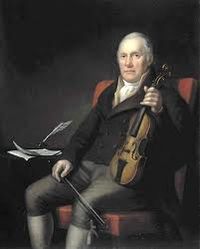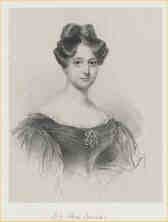Annotation:Lady Louisa Gordon: Difference between revisions
No edit summary |
No edit summary |
||
| (12 intermediate revisions by 2 users not shown) | |||
| Line 1: | Line 1: | ||
------------ | |||
---- | {{TuneAnnotation | ||
|f_tune_annotation_title= https://tunearch.org/wiki/Annotation:Lady_Louisa_Gordon > | |||
'''LADY LOUISA GORDON'S REEL'''. AKA and see "[[ | |f_annotation='''LADY LOUISA GORDON'S REEL'''. AKA and see "[[Little Peggy's Love (2)]]," "[[Miss McLeod’s Favorite]]/Fancy," "[[Miss Farquharson of Invercauld's Strathspey (1)]]," "[[Peggy's Love]]." Scottish, Strathspey. F Major. Standard tuning (fiddle). AABB. Composed by [[Biography:William Marshall]] (1748-1833), and first appearing in print in his 1781 collection. Robert Burns called Marshall "the greatest composer of strathspeys of the age." Madame Hillsburgh, a celebrated stage dancer of the first half of the nineteenth century, danced to this tune at the Edinburgh Opera House (before 1845). The Gows renamed the tune "Miss M'Leod's Fancy" and did not give composition credit to Marshall until their '''Sixth Collection.''' The melody can be found in Marshall's posthumous collection (1845) under the title "[[Miss Farquharson of Invercauld's Strathspey (1)]]." Marshall was employed by the Duke of Gordon as Steward of the household, and later served as Factor of the Gordon estates. | ||
[[File:marshall.jpg|200px|thumb|left|William Marshall]] | [[File:marshall.jpg|200px|thumb|left|William Marshall]]The tune appears as "Peggy's Love" in dancing master Thomas Wilson's '''Companion to the Ball Room''' (London, 1816). | ||
<br> | <br> | ||
<br> | <br> | ||
[[File:louisagordon.jpg|290px|thumb|right|Lady Louisa Cornwallis]] | |||
Lady Louisa was the fourth daughter of the beautiful and witty Jane Maxwell. Louisa's father was Alexander, 4th Duke of Gordon (Marshall's patron and employer), but Moyra Cowie ('''The Life and Times of William Marshall''', 1999) says that daughter Louisa was reputed not to have been a Gordon child. "When Louisa married...Jane Maxwell insisted Louisa 'had not a drop of Gordon blood in her veins!', in response to the Marquis's concerns that insanity ran in the Duke of Gordon's family." Jane was "indefatigable in her ambition," writes Mary Robinson ('''Beaux and Belles of England'''), and, although her daughters were far less beautiful than she, skilful diplomacy found exquisite matches for each of them. Louisa married Charles, Lord Broome, the son of the Marquis of Cornwallis, "the justly celebrated Governor of India." Charles succeeded his father as the second Marquis of Cornwallis. | Lady Louisa was the fourth daughter of the beautiful and witty Jane Maxwell. Louisa's father was Alexander, 4th Duke of Gordon (Marshall's patron and employer), but Moyra Cowie ('''The Life and Times of William Marshall''', 1999) says that daughter Louisa was reputed not to have been a Gordon child. "When Louisa married...Jane Maxwell insisted Louisa 'had not a drop of Gordon blood in her veins!', in response to the Marquis's concerns that insanity ran in the Duke of Gordon's family." Jane was "indefatigable in her ambition," writes Mary Robinson ('''Beaux and Belles of England'''), and, although her daughters were far less beautiful than she, skilful diplomacy found exquisite matches for each of them. Louisa married Charles, Lord Broome, the son of the Marquis of Cornwallis, "the justly celebrated Governor of India." Charles succeeded his father as the second Marquis of Cornwallis. | ||
|f_source_for_notated_version= | |||
|f_printed_sources=Glen ('''The Glen Collection of Scottish Dance Music, vol. 1'''), 1891; p. 14. Marshall, Fiddlecase Edition, 1978; '''1781 Collection''', p. 7. Robbins Music Corp. ('''The Robbins collection of 200 jigs, reels and country dances'''), New York, 1933; No. 95, p. 30. | |||
|f_recorded_sources=Culburnie COL 102, Alasdair Fraser & Jody Stecher - "The Driven Bow" (1988). Culburnie COL 113D, Alasdair Fraser & Tony McManus - "Return to Kintail" (1999). | |||
|f_see_also_listing= | |||
}} | |||
------------- | |||
'' | |||
'' | |||
---- | |||
Latest revision as of 02:40, 8 November 2022
X:1 T:Lady Louisa Gordon M:C L:1/8 R:Strathspey S:Glen Collection, vol. 1 (1891) Z:AK/Fiddler's Companion K:F A|C>FF>G A>GA>F|D<G G>A (B2 B<)c|d<fc<A G>F G<A|C>FE>G F3:| |:e|f>c f<a f>c f<a|fcfa g2 g<a|f>c c<A f>b a<g|f<d c>A G3:|
LADY LOUISA GORDON'S REEL. AKA and see "Little Peggy's Love (2)," "Miss McLeod’s Favorite/Fancy," "Miss Farquharson of Invercauld's Strathspey (1)," "Peggy's Love." Scottish, Strathspey. F Major. Standard tuning (fiddle). AABB. Composed by Biography:William Marshall (1748-1833), and first appearing in print in his 1781 collection. Robert Burns called Marshall "the greatest composer of strathspeys of the age." Madame Hillsburgh, a celebrated stage dancer of the first half of the nineteenth century, danced to this tune at the Edinburgh Opera House (before 1845). The Gows renamed the tune "Miss M'Leod's Fancy" and did not give composition credit to Marshall until their Sixth Collection. The melody can be found in Marshall's posthumous collection (1845) under the title "Miss Farquharson of Invercauld's Strathspey (1)." Marshall was employed by the Duke of Gordon as Steward of the household, and later served as Factor of the Gordon estates.


Lady Louisa was the fourth daughter of the beautiful and witty Jane Maxwell. Louisa's father was Alexander, 4th Duke of Gordon (Marshall's patron and employer), but Moyra Cowie (The Life and Times of William Marshall, 1999) says that daughter Louisa was reputed not to have been a Gordon child. "When Louisa married...Jane Maxwell insisted Louisa 'had not a drop of Gordon blood in her veins!', in response to the Marquis's concerns that insanity ran in the Duke of Gordon's family." Jane was "indefatigable in her ambition," writes Mary Robinson (Beaux and Belles of England), and, although her daughters were far less beautiful than she, skilful diplomacy found exquisite matches for each of them. Louisa married Charles, Lord Broome, the son of the Marquis of Cornwallis, "the justly celebrated Governor of India." Charles succeeded his father as the second Marquis of Cornwallis.

